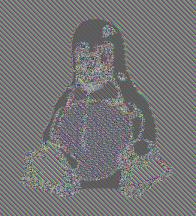In the Wikipedia Article on Block Cipher Modes they have a neat little diagram of an unencrypted image, the same image encrypted using ECB mode and another version of the same image encrypted using another method.



At university I have developed my own implementation of DES (you can find it here) and we must demo our implementation in a presentation.
I would like to display a similar example as shown above using our implementation. However most image files have header blocks associated with them, which when encrypting the file with our implementation, also get encrypted. So when you go to open them in an image viewer, they are assumed to be corrupted and can't be viewed.
I was wondering if anybody new of a simple header-less image format which we could use to display these? Or if anyone had any idea's as to how the original creator of the images above achieved the above result?
Any help would be appreciated,
Thanks
Note: I realise rolling your own cryptography library is stupid, and DES is considered broken, and ECB mode is very flawed for any useful cryptography, this was purely an academic exercise for school. So please, no lectures, I know the drill.